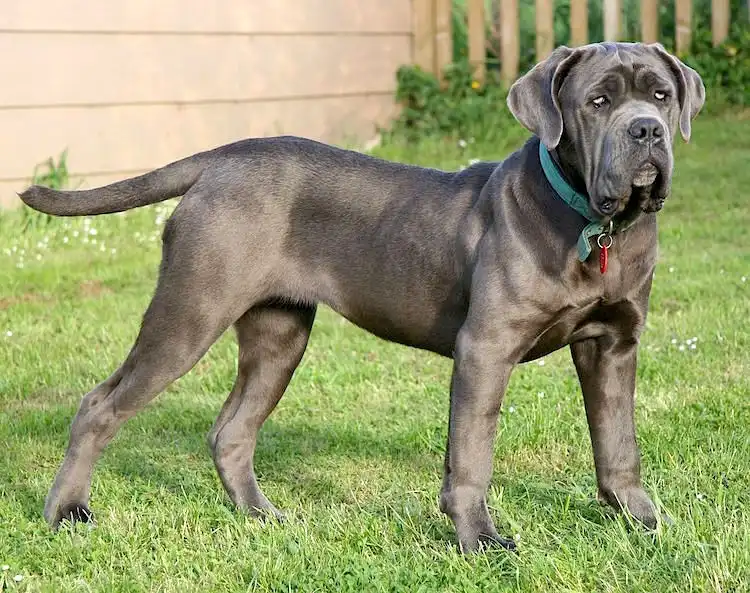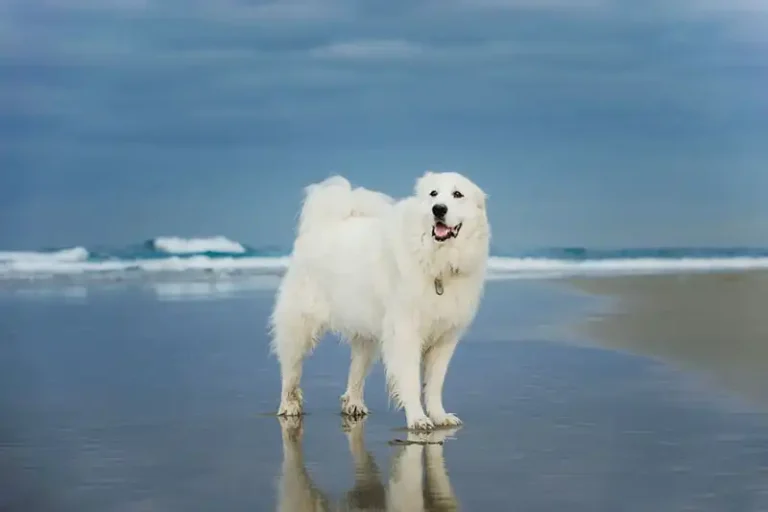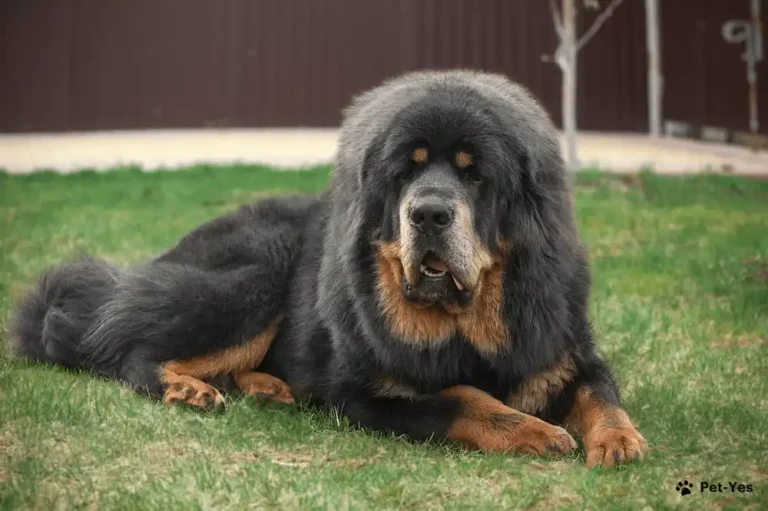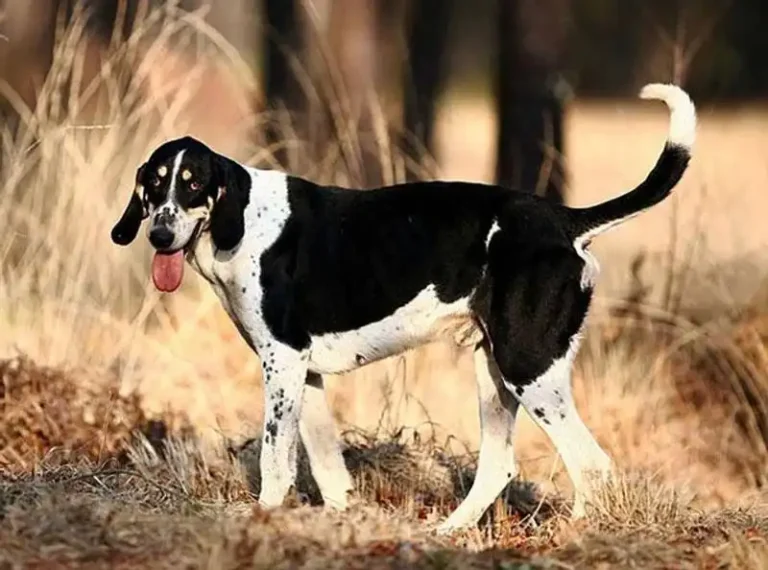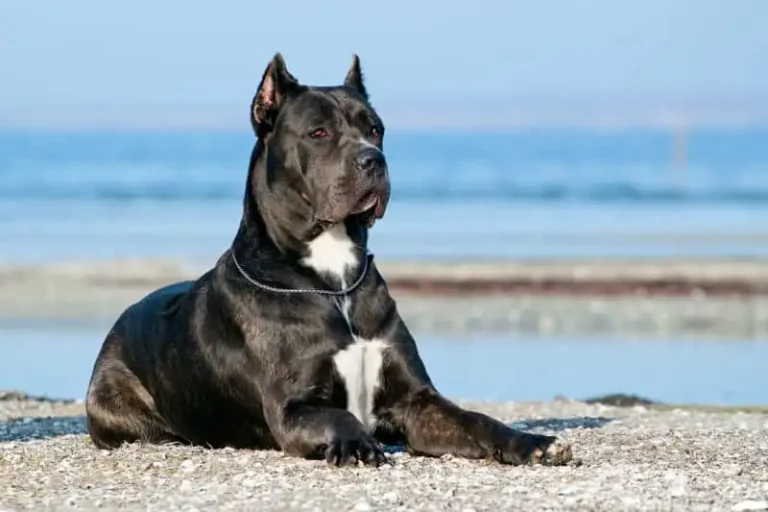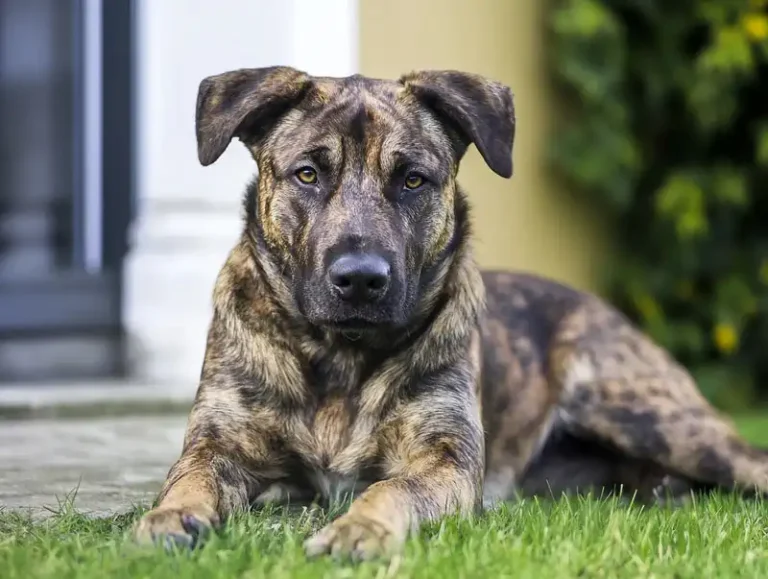Neapolitan Mastiff – Description-Breed-Character-Pet care
The Main Thing About the Neapolitan Mastiff
- These dogs have existed for about four thousand years, and are mentioned by Aristotle, Plutarch, the Roman agronomist Columella in his work “On Agriculture”, and Virgil.
- Among the drawings and bas-reliefs that have survived from ancient times, there are images of powerful molossers covered in folds of skin.
- According to one version, the name “mastino” comes from the Latin “masuetinus”, which translates as “tamed”.
- Neapolitan Mastiffs share a common origin with the Cane Corso and are considered the ancestors of a number of European guard dogs.
- The work to restore and develop the population, which almost disappeared after the Second World War, began in 1946 and continues to this day.
- Italian dog clubs and breed lovers have formed and maintain a special breeding program aimed at strengthening the gene pool and maintaining the homogeneity of the phenotype.and prevent the development of a large number of hereditary diseases.
- In modern art, the Neapolitan Mastiff is best known for its role as Fang in the Harry Potter films. A total of seven dogs played the role.
- The breed has a personal holiday, it is celebrated on May 10.
- Dogs are the twelfth largest and heaviest animals in the world.
- A mastiff named Hercules is listed in the Guinness Book of Records as the heaviest dog, weighing 128 kg.
How did dogs of this breed appear?
The ancestors of the Neapolitan Mastiff are powerful dogs from central Italy, related to the Molossians and living in those regions for over four thousand years. They guarded legionary camps, dwellings, herded cattle and hunted large game.
Aristotle and Plutarch wrote about them, the Roman poet Virgil mentioned them. Their predecessors were once brought by the Phoenicians from Mesopotamia, where they were also military dogs. The breed’s roots also go back to Tibet, to local mastiffs, considered the ancestors of all currently existing Molossians.
It is not possible to trace the development in different periods of history, the dogs were formed naturally, with minimal human participation, which was limited to the selection of the best puppies. The first description was compiled in 1897 by Professor Tezze from Naples, later an official standard was formulated on its basis. Despite their popularity, the dogs remained unrecognized.
This continued until World War II, during which the Neapolitan Mastiff population was almost completely destroyed. The breed was restored thanks to the writer and cynologist Piero Scanziani, who saw the dogs at the first post-war exhibition held in 1946. Captivated by their majestic appearance, he persuaded the owner to sell him a male named Guaglione and a female named Paciana.
This pair laid the foundation for the modern population. Scanziani, together with other enthusiasts, edited the standard, achieved registration of Neapolitan Mastiffs by the Italian Kennel Club in 1949, founded an association of breed lovers, and contributed greatly to its development and prosperity. The FCI recognized these beauties in 1956.
Nowadays they are known all over the world, bred in most countries, including Russia, but remain relatively rare.
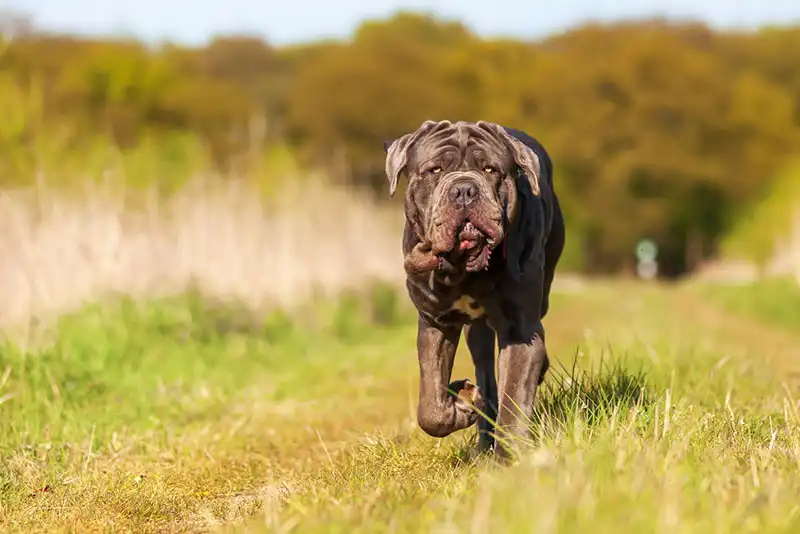
Description of the Neapolitan Mastiff
Externally, this is a large, voluminous and heavy dog with expressive folds all over the body, mainly on the head and muzzle. The melancholic look and unhurriedness emphasize the powerful physique. It is impossible to confuse this breed with any other.
The FCI standard has been rewritten several times, with corrections made to better match the historical appearance, which Italian cynologists have managed to restore and now diligently maintain. The current version came into force on 01.01.2016.
Head
Short, massive, wide in the cranial part, especially between the ears, slightly convex in the forehead area from the frontal angle. Cheekbones are pronounced, but without large muscles, superciliary arches are developed, longitudinal groove is clearly visible, occipital protuberance is barely noticeable. Transition to the facial area is high and distinct.
The muzzle is deep, almost cubic in shape, equal to a third of the head. The nose continues the general line, does not protrude beyond the front edge, its pigmentation corresponds to the main color. The lips are fleshy, thick, the upper ones form the contour of the lower part of the muzzle, the mucous membrane is visible in the corners. The jaws are powerful, the bite is straight or scissor-like, an undershot bite is allowed without a departure.
Eyes
Rounded, but not protruding or sunken too deeply. Set wide apart, with drooping eyelids. The color is usually darker than the base coat, with rare exceptions. The folds should not obscure the dog’s field of vision.
Ears
In relation to the size of the animal, they are quite modest in size. Triangular, natural shape, the fabric is flat, soft, fits tightly on the cheekbones. Set relatively high.
Neck
Shortened, but not too much, conical, the upper side has a slight curve. The muscles are well developed. The skin forms a double, clearly separated, abundant, but not exaggerated, dewlap, starting from the jaw in the area of the lips and reaching the middle of the neck.
Frame
The length is 15% greater than the height. The back is level, with a wide, slightly pronounced withers, harmonious loin and protruding pelvic bones. The chest is very voluminous, with a large girth, rounded ribs and strong muscles, the edge of the sternum is at shoulder level.
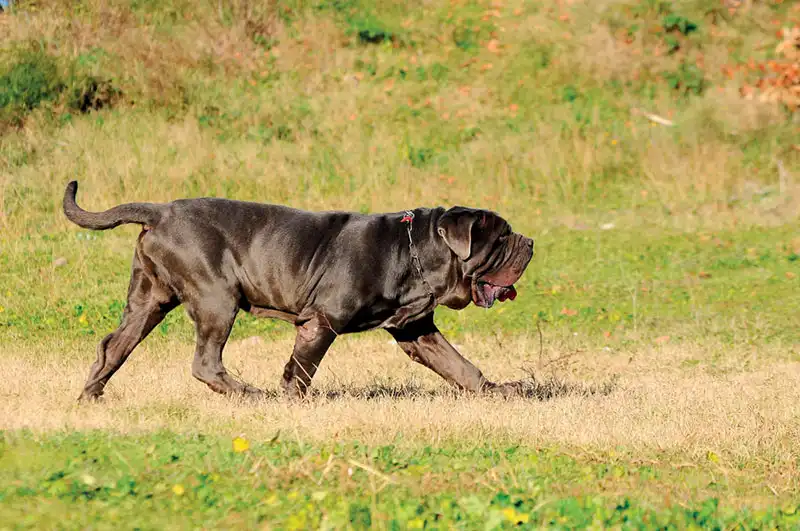
Tail
Thick at the base, moderately tapering towards the end. Reaches the hock. When at rest, it is lowered, curved like a sabre, and when moving or alert, it is raised to the horizontal or slightly higher.
Limbs
The front is vertical, with a massive bone structure, proportional. The shoulder blades are sloping, the joints are good, not turned out, a powerful muscular frame. The back ones are harmonious, starting from the maximally developed pelvic bones, the angles of the joints are correct, the muscles are fleshy, relief. The paws are rounded, the front ones are larger, collected, arched, with fully pigmented pads and hard claws.
Movements
The gaits are typical. The stride is close to that of a cat. It is characterized by a lion’s majesty and a bear’s leisurely pace. The trot is wide, with a powerful push and reach of the limbs. The gallop is rare and is not evaluated in the ring. An amble is acceptable.
Wool
The hair is short and dense, of uniform length over the entire body, no longer than 1.5 cm, without the slightest signs of feathering. The skin is abundant, thick, forming large, loose folds over the entire body, especially on the head and throat. It is a distinctive feature of the breed. It should not create discomfort for the pet.
Color
Preferred colors are gray, lead, and black, along with fawn, brown, and red deer. Small white markings on the chest and paw tips are acceptable. Any coloring can be brindle. Isabella (yellowish gray), hazel, and blue tones are not considered a defect.
Size
Sexual dimorphism is clearly expressed. Males grow up to 65-75 cm, weighing 60-70 kg, females – up to 60-68 cm, their weight is 50-60 kg. Larger or smaller proportions are not allowed.
Mastiff character
The Neapolitan Mastiff cannot be called active, it is a slow majestic dog with a deeply phlegmatic temperament. Such a dog will not rush to run after a ball, preferring to walk sedately next to the owner. With its impressive height and large mass, it looks impressive, but remains one of the calmest and most balanced breeds.
At the same time, it is very stern and strict. The highest security qualities, this incorruptible guard treats strangers with extreme suspicion, but will not make an unnecessary move until he is sure of the stranger’s unreliability. He will stop the intruder and detain him until the owner arrives. He will show speed and strength only if his owners are threatened with attack.
For his family, the Neapolitan Mastiff will become a reasonable, benevolent and balanced pet, devoted and easy to communicate with. He equally loves both adults and children, not refusing to play with the latter, ready to protect them. You should not leave the dog alone with children – he has never been used as a nanny and does not know how to properly handle them, given his large size and weight, this can lead to undesirable consequences.
From an early age, the puppy chooses one person for itself, establishing the closest connection with him. Separation from the beloved owner is very difficult for him, leaving him for a long time is undesirable. He treats other members of the household much more simply, without such deep emotions.
The dominance that is characteristic of all large guard dogs is also inherent in the Neapolitan Mastiff. This makes it an unsuitable choice for beginner dog owners; training will require skills in working with such animals and a firm hand.
The dog has a good relationship with the four-legged inhabitants of the house, especially if they grew up together. He rarely makes friends with other dogs, and it is not recommended to get new pets when the pet has already grown up.
He is not prone to noise and barking at all. He prefers to act quietly and quickly, so he needs strict discipline and socialization.
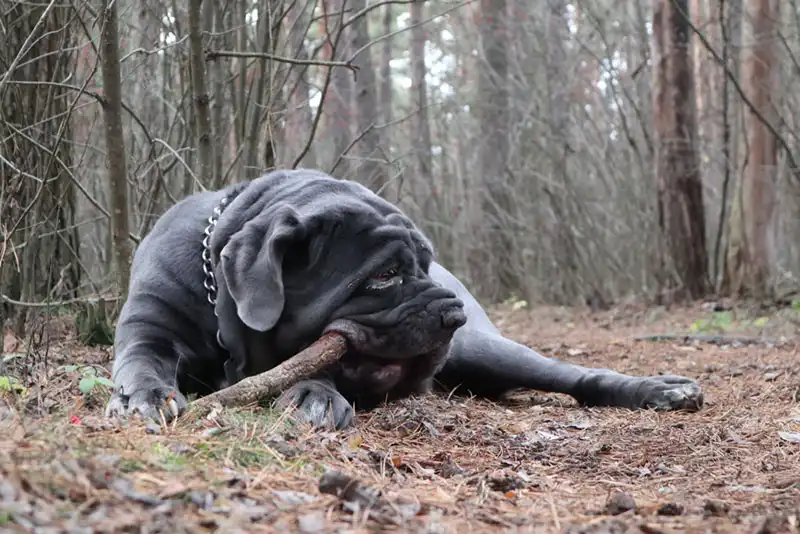
Education and training of the breed
Like any powerful, independent and dominant dog, the Neapolitan Mastiff needs an experienced, self-confident owner. Without proper control and obedience skills, the puppy will not listen to orders, and you will not be able to restrain an adult dog who wants to find out something or meet someone without permission. Considering that his appearance can scare even from a great distance, proper training is necessary.
Experienced owners are also advised to train their pet under the guidance of a professional dog trainer , this will help make the training as productive as possible.
You will not achieve submission by being rude and harsh, you will only offend the dog and make it uncontrollable. Along with strictness and authority, tact and patience are necessary in work, helping to achieve mutual respect.
The best motivation is praise.
- First of all, they practice those commands that will allow you to control your pet outside the house – “come”, “no” and “heel”, the dog must obey them unquestioningly.
- Socialization is of primary importance, from the first months the puppy firmly remembers that strangers on the street do not pose a threat to either him or his family. It is better to start getting acquainted with urban conditions and noise gradually, without sudden jumps.
- Short trips to quiet places will be the first step on this path. Later they become more intense and longer, with visits to noisy streets, transport, etc.
- Try to introduce him to as many other dogs as possible, friendly and balanced, they can become friends with your pet, in adulthood he is not inclined to get along with other animals, but those he knows well he will love and will happily play with.
- Strictly demand compliance with the house rules, the comfort of your coexistence depends on them. Undesirable moments in behavior are smoothed out by practicing the appropriate commands – “no” or “no”.
- Neapolitan Mastiffs are not suitable for participation in sports events, their massive build and slowness do not allow them to show sufficient agility. They are also not used as service dogs, for similar reasons. The best role for this breed in the modern world is a pet or a guard.
Pet care
When purchasing such a large four-legged friend, make sure that you and your family members will be comfortable with it. The dog itself will not attach much importance to the area of the home, it does not require constant movement, a cozy soft bed is much more important, but people are not always comfortable being with a large dog in a limited space. A fenced yard of a private house will be another pleasant place for relaxation or leisurely walks of the Neapolitan Mastiff, but in general its presence or absence does not play a special role.
Despite his slowness and phlegmatic nature, he still needs physical exercise. In this case, we are not talking about jogging or active sports, but about walking with the owner along the park paths or forest trails, playing a little, but not far and not for long.
The Neapolitan Mastiff is extremely sensitive to weather conditions.
He dislikes both heat and cold equally, easily catches a cold even in moderately cool weather, and therefore warm clothes in winter and cooling ones in summer are very important. Also protect him from drafts.
The fur is small and almost does not shed, it is enough to periodically remove dead hairs with a soft brush. The skin requires more care, dust, moisture and dirt accumulate in its folds, which can provoke dermatitis. All areas of the body are regularly wiped and examined, down to the fine wrinkles, it does not take much time, but skipping hygiene procedures is fraught with consequences in the form of inflammation, rashes and itching . It is advisable to wash a couple of times a month with a special shampoo.
Dogs have strong claws, and given their low mobility, they do not have time to wear them down on the ground themselves. You can shorten the overgrown part with a clipper or nippers. This is associated with the risk of injuring the pad and the living area. It is safer to trust the work to a professional or learn under his supervision. Excessively long claws change the gait and negatively affect the joints, which are already under considerable strain, and breakage or cracks are extremely painful.
Teeth are cleaned about once a week with veterinary pastes and special brushes. Ear wax is removed with wipes soaked in disinfectant lotion. Lips and muzzle are wiped as needed, most often after meals.
The puppy is accustomed to care and hygiene from the first months so that he accepts them calmly and does not resist.
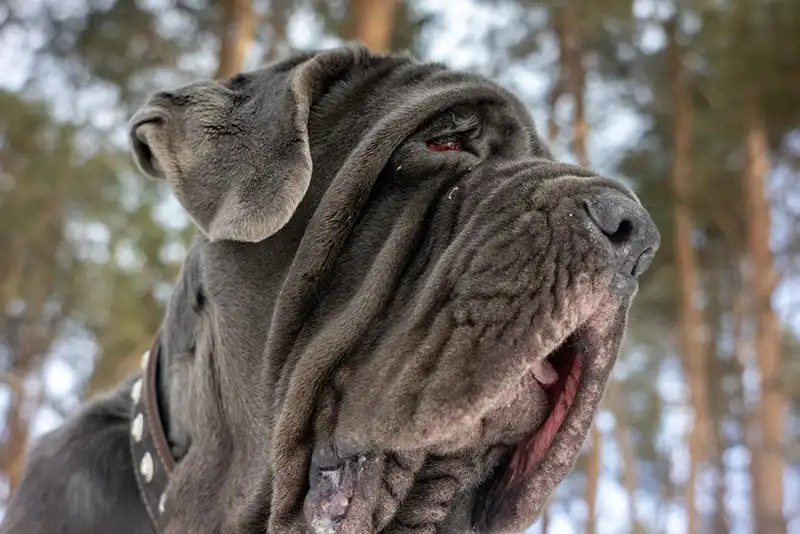
Nutrition
The Neapolitan Mastiff is a sedentary dog, it requires appropriate food, that is, with low caloric content, but containing all the necessary substances in the proper amount. In addition to the level of activity, the diet is influenced by the age and health of the pet.
Experts consider high-quality ready-made products to be the most useful in terms of balance and digestibility. They take into account the needs that depend on the characteristics – well-known reliable companies produce wide lines that allow you to quickly select the best option, focusing on a specific dog.
For Neapolitan Mastiffs, those intended for large animals that are not energetic are suitable. In addition to the composition, they are distinguished by large granules that slow down chewing and thus improve absorption. Mixing dry and wet varieties is acceptable, but within the same brand, in order to be able to calculate the caloric content and the amount of incoming micro- and macronutrients– all manufacturers include different additives, which in combination complicate this process.
With a natural diet, the menu should be created by a nutritionist, as it requires serious knowledge. It is difficult to follow the recommendations, the same products may differ in the content of nutrients. It is acceptable to include lean meats, buckwheat and rice porridge, sea fish, vegetables, such as carrots or pumpkin, cottage cheese, etc. Prohibited treats include chocolate, alcohol, pastries, coffee, garlic and onions, smoked meats, bones, legumes, avocado, grapes, etc.
Like all massive breeds, the Neapolitan Mastiff is prone to gas and flatulence. To reduce such manifestations, follow a regimen, do not feed before a walk, monitor the freshness and quality of food, wash the bowl immediately after eating. These simple precautions will stabilize the work of the gastrointestinal tract.
The average fluid requirement for a dog is approximately 60-120 ml per kilogram of body weight, depending on the presence of any diseases, the ambient temperature and the animal’s activity. Clean drinking water should always be available.
Health
Neapolitan Mastiffs face a number of problems throughout their lives. Most are due to their body structure, but there are also hereditary problems.
The most typical are the following:
Dysplasia is abnormally formed tissue, with the head and socket of the hip or elbow joint not anatomically matching each other. It develops due to unbalanced nutrition and excessively high loads at a young age. The skeleton of representatives of this breed is formed slowly, it is especially important to protect Neapolitan Mastiff puppies, as their bones are quite fragile. Heavy exercises such as climbing stairs, taking obstacles or overly active games should be completely excluded. It is harmful to allow both a shortage and an excess of essential substances in the diet.
- Cardiomyopathy is a disease that affects the myocardium, the muscle layer located in the middle of the heart. It is expressed in impaired blood circulation, progressive heart failure and arrhythmia.
- Cherry eye syndrome is a defect of the third eyelid in which it falls out in the form of a round, fleshy, red mass. Treatment depends on the stage, up to and including surgical intervention, which consists of fixing the gland.
- Dermatitis – develops due to non-compliance with hygiene rules; skin folds, ears and lips need to be regularly wiped and cleaned.
- Hyperuricosuria is the accumulation of uric acid salts with subsequent formation of stones.
Colds – Neapolitan Mastiffs are extremely sensitive to cold and drafts. - Progressive retinal atrophy is the destruction of the visual cells of the inner lining of the eye and its detachment. It is transmitted genetically. The ow
- Infections and parasite infestations are a serious threat to any dog. Do not skip annual vaccinations under any circumstances and treat your four-legged friend for worms and ticks in a timely manner.
- Do not forget that only a doctor can prescribe treatment based on the results of the examination; taking measures on your own is very dangerous.
- Veterinarians strongly recommend bringing dogs to the clinic for examination twice a year; this measure makes it possible to diagnose the disease at an early stage.
What kind of owner is this breed suitable for?
The Neapolitan Mastiff is not the easiest dog in terms of character; it requires responsibility and certain skills.
- Here are some recommendations for future owners:
- Beginner dog owners should choose another breed, all mastiffs require careful training, experience of communication with independent and dominant pets. A professional dog handler or an experienced owner will cope with such a task much more successfully.
- Suitable for people who are not prone to high activity; walks should be leisurely and short, although regular.
- Can be a good family dog, loves children and all household members, but becomes most attached to one person.
- Not suitable for sports, hiking and other types of energetic recreation, including outdoor activities.
- It is undemanding to its place of residence and feels equally at home in the city and in the village.
- In regions with a harsh climate, there is a high probability of colds, this should be taken into account before getting a Neapolitan Mastiff.
- Thanks to its short coat, which has no undercoat and practically does not shed, it can become a faithful companion for allergy sufferers, but you should focus on the individual characteristics of your body.
Not a recommended option for the elderly or those with health limitations.
Famous Owners
Among those who have ever owned a Neapolitan Mastiff, there have been some truly epochal personalities. It is worth noting Alexander the Great, who was given two dogs by the king of India, this story is described by Pliny the Elder.
Another equally famous ruler who kept this breed was Cyrus the Great, the king of Persia. Many Roman patricians willingly kept these animals to guard their homes, as did the nobility of Italy in later centuries.
How to choose the right puppy
Neapolitan Mastiffs are bred in most countries, including here in Russia, this situation makes it possible to buy a baby relatively close to home. Breeding nurseries and breeders are not in all regions, but in many, which makes the task much easier.
Be skeptical about ads on websites, of course, many reliable organizations and specialists post offers there, but there is a high risk of running into unverified sellers. It is safer to contact a club or nursery directly, which are easy to find online, but before writing to the owners, be sure to look for reviews about them. Sometimes, nurseries also have unscrupulous specialists who get offspring from obviously sick animals.
Before buying, try to find out as much as possible about your future pet. Check its pedigree, availability of veterinary documents, recommendations for care, feeding and health. If you plan to show the dog in the ring, then inquire about the titles of the parents, the presence of older brothers and sisters and their successes at exhibitions. It is best to meet the baby and pick it up in person, if this is not possible, ask to send photos and videos and make sure that a responsible experienced person is engaged in transportation.
Personal experience of ownership
Since the breed is quite well known, there is no shortage of reviews about it.
We present some of them, the most typical ones:
- Good-natured and proud, playful and brave, uncompromisingly loyal, they perfectly understand the meaning and intonation of speech, and subtly sense the mood of their owners.
- Raising and raising a Neapolitan Mastiff is extremely challenging, with many unexpected behavioral, health, and other issues arising.
- They do not tolerate aggression in the family; when someone tries to argue and swear, they immediately try to separate them and seat them in different corners.
- Due to their size and some awkwardness, they can damage the furnishings in the house.
They are unhurried and stubborn, think slowly and respond to commands, which makes - Amazing guards, won’t let anyone near, will sit and guard as long as you like. Difficult to keep in an apartment, require a lot of space.
- They are incredibly vulnerable and remember grievances for a long time.
- They love care and attention. You need to monitor their health, the main threat is colds, the dog is gentle, demanding of warmth.
- They don’t live long , this is the most serious drawback.
Cost of puppies
The price of a Neapolitan Mastiff in Russia starts from 50 thousand rubles and can exceed 150 thousand rubles, it depends on the city where the breeder lives, the pedigree of the puppies and their class.
The most expensive ones are those that have titled parents and the most outstanding exterior, allowing them to claim high awards. If you buy a pet in another region, find out the cost of transportation in advance, it is formed based on the distance and type of transport.

